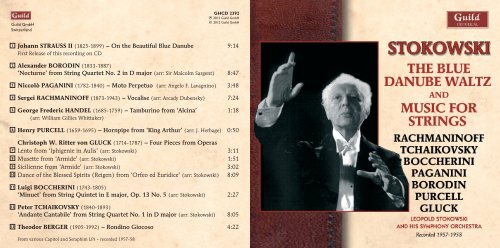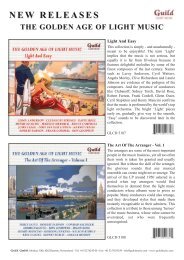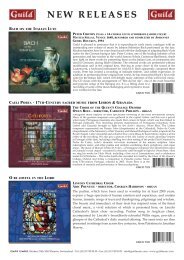Johann STRAUSS II (1825-1899) – On the Beautiful Blue Danube 9 ...
Johann STRAUSS II (1825-1899) – On the Beautiful Blue Danube 9 ...
Johann STRAUSS II (1825-1899) – On the Beautiful Blue Danube 9 ...
You also want an ePaper? Increase the reach of your titles
YUMPU automatically turns print PDFs into web optimized ePapers that Google loves.
Guild GmbH<br />
Switzerland<br />
GHCD 2392<br />
2012 Guild GmbH<br />
© 2012 Guild GmbH<br />
1<br />
2<br />
<strong>Johann</strong> <strong>STRAUSS</strong> <strong>II</strong> (<strong>1825</strong>-<strong>1899</strong>) <strong>–</strong> <strong>On</strong> <strong>the</strong> <strong>Beautiful</strong> <strong>Blue</strong> <strong>Danube</strong> 9:14<br />
First Release of this recording on CD<br />
Alexander BORODIN (1833-1887)<br />
‘Nocturne’ from String Quartet No. 2 in D major (arr: Sir Malcolm Sargent) 8:47<br />
3<br />
4<br />
5<br />
6<br />
Niccolò PAGANINI (1782-1840) <strong>–</strong> Moto Perpetuo (arr: Angelo F. Lavagnino) 3:48<br />
Sergei RACHMANINOFF (1873-1943) <strong>–</strong> Vocalise (arr: Arcady Dubensky) 7:24<br />
George Frederic HANDEL (1685-1759) <strong>–</strong> Tamburino from ‘Alcina’ 1:18<br />
(arr: William Gillies Whittaker)<br />
Henry PURCELL (1659-1695) <strong>–</strong> Hornpipe from ‘King Arthur’ (arr: J. Herbage) 0:50<br />
7<br />
8<br />
9<br />
10<br />
11<br />
12<br />
13<br />
Christoph W. Ritter von GLUCK (1714-1787) <strong>–</strong> Four Pieces from Operas<br />
Lento from ‘Iphigenie in Aulis’ (arr: Stokowski) 3:11<br />
Musette from ‘Armide’ (arr: Stokowski) 1:51<br />
Sicilienne from ‘Armide’ (arr: Stokowski) 3:02<br />
Dance of <strong>the</strong> Blessed Spirits (Reigen) from ‘Orfeo ed Euridice’ (arr: Stokowski) 8:09<br />
Luigi BOCCHERINI (1743-1805)<br />
‘Minuet’ from String Quintet in E major, Op. 13 No. 5 (arr: Stokowski) 2:27<br />
Peter TCHAIKOVSKY (1840-1893)<br />
‘Andante Cantabile’ from String Quartet No. 1 in D major (arr: Stokowski) 8:05<br />
Theodor BERGER (1905-1992) <strong>–</strong> Rondino Giocoso 4:22<br />
From various Capitol and Seraphim LPs <strong>–</strong> recorded 1957-58
A GUILD HISTORICAL RELEASE<br />
• Master source: Records from <strong>the</strong> collection of Edward Johnson<br />
• Remastering from <strong>the</strong> original LPs: Peter Reynolds<br />
• Final master preparation: Reynolds Mastering, Colchester, England<br />
• Design: Paul Brooks, Design and Print, Oxford<br />
• Art direction: Guild GmbH<br />
• Executive co-ordination: Guild GmbH<br />
■<br />
■<br />
■<br />
Guild GmbH, Moskau 314b, 8262 Ramsen, Switzerland<br />
Tel: +41 (0) 52 742 85 00 Fax: +41 (0) 52 742 85 09 (Head Office)<br />
Guild GmbH, PO Box 5092, Colchester, Essex CO1 1FN, Great Britain<br />
e-mail: info@guildmusic.com World WideWeb-Site: http://www.guildmusic.com<br />
Leopold Stokowski and Sir Malcolm Sargent, 1951<br />
WARNING: Copyright subsists in all recordings under this label. Any unauthorised broadcasting, public<br />
performance, copying or re-recording <strong>the</strong>reof in any manner whatsoever will constitute an infringement of such<br />
copyright. In <strong>the</strong> United Kingdom licences for <strong>the</strong> use of recordings for public performance may be obtained from<br />
Phonographic Performances Ltd., 1 Upper James Street, London W1F 9EE.
as a composer of music for films. The Russian-American composer and violinist Arcady Dubensky<br />
(1890-1966) had <strong>the</strong> distinction of a work by him, a setting of Edgar Allan Poe’s poem The Raven<br />
for speaker and orchestra, being performed by Stokowski and <strong>the</strong> Philadelphia Orchestra in <strong>the</strong><br />
1932 season; more than twenty years later, <strong>the</strong> conductor was to record Dubensky’s transcription<br />
for string orchestra of Rachmaninoff ’s Vocalise, a wordless song originally published in 1912.<br />
Two o<strong>the</strong>r transcriptions by English musicians of English music follow: <strong>the</strong> Tamburino from<br />
Handel’s opera ‘Alcina’ in <strong>the</strong> version by <strong>the</strong> Northumbrian composer William Gillies Whittaker,<br />
and <strong>the</strong> Hornpipe from Purcell’s ‘King Arthur’ as arranged by Julian Herbage, better known in his<br />
later years as a BBC radio presenter of <strong>the</strong> classical music programme ‘Music Magazine’ on which<br />
Stokowski himself appeared.<br />
Finally, <strong>the</strong> original piece for string orchestra by <strong>the</strong> Austrian composer Theodor Berger, his<br />
delightful Rondino Giocoso, about which we commented earlier, brings this fascinating programme<br />
to its close.<br />
© Robert Mat<strong>the</strong>w-Walker, 2012<br />
GHCD 2379-80 GHCD 2388-89<br />
6<br />
No matter how one considers <strong>the</strong> career of Leopold Stokowski, one is constantly brought<br />
up short by an event, a fact of his long life, an aspect of his creativity that one may never,<br />
or hardly ever, have considered before.<br />
<strong>On</strong>e may expect much from a musician who performed well into his nineties and recorded<br />
regularly for around sixty years. Stokowski may not have been <strong>the</strong> longest-lived conductor, but<br />
he was <strong>–</strong> surely <strong>–</strong> <strong>the</strong> most recorded, leaving a legacy that is not, 35 years after his death, as fully<br />
appreciated as it deserves to be. <strong>On</strong>e reason is that it takes a considerable leap of imagination to<br />
consider that when Stokowski was born in 1882, Richard Wagner was still alive and Brahms had<br />
not yet begun his Third Symphony; yet at <strong>the</strong> time of Stokowski’s death in 1977, he would certainly<br />
have been aware of <strong>the</strong> rise of Punk Rock as exemplified by <strong>the</strong> Sex Pistols and The Clash, through<br />
his sons’ interest in popular music of <strong>the</strong> time <strong>–</strong> <strong>the</strong>y formed and appeared in <strong>the</strong>ir own rock band<br />
with <strong>the</strong>ir fa<strong>the</strong>r’s encouragement.<br />
Stokowski retained a lifelong interest in <strong>the</strong> latest developments in music <strong>–</strong> popular as well as<br />
classical <strong>–</strong> and his career is punctuated by a succession of premieres that at <strong>the</strong> time exemplified <strong>the</strong><br />
latest trends. Stokowski also knew that a creative artist needs, above all, encouragement, and during<br />
his long life he encouraged very many composers, as shown by <strong>the</strong> astonishing list of around 2,000<br />
premieres he conducted.<br />
His work in opera, apart from concert hall repertoire and in <strong>the</strong> recording studio, is ano<strong>the</strong>r<br />
aspect of his career which is not fully grasped today; and although he made many recordings,<br />
few are of him conducting opera. Yet of all <strong>the</strong> great conductors of <strong>the</strong> 20th century, Stokowski’s<br />
recorded legacy does, on balance, detail <strong>the</strong> enormous range of his repertoire, his respect for <strong>the</strong><br />
score, and his willingness to change it on occasion when he felt it necessary to make <strong>the</strong> musical<br />
point (a characteristic for which he was often criticised, yet which seems to have gone unremarked<br />
upon when practised by many of his contemporaries).<br />
Stokowski’s encouragement of new music was matched by his determination to ensure that <strong>the</strong><br />
established repertoire reached <strong>the</strong> widest possible audience. He was <strong>the</strong> first conductor to record<br />
all of Brahms’s Symphonies <strong>–</strong> and with <strong>the</strong> same orchestra <strong>–</strong> and remains <strong>the</strong> only conductor to<br />
have performed all of Schoenberg’s orchestral music during <strong>the</strong> composer’s lifetime, giving two<br />
3
world premieres en route. As a fully trained church organist, being a Fellow of <strong>the</strong> Royal College<br />
of Organists, he was not only assistant to Walford Davies at <strong>the</strong> Temple Church in London but also<br />
orchestrated many of Bach’s organ works with a view to making <strong>the</strong>m more accessible to generations<br />
of music-lovers who never attended organ recitals in churches or ca<strong>the</strong>drals.<br />
And so it is that, whichever aspect of Stokowski’s career is studied, one encounters details<br />
which are rarely appreciated even today. Mention his name to many music-lovers and <strong>the</strong> image of<br />
a conductor directing a large symphony orchestra will most readily come to mind: yet here, in this<br />
collection of <strong>–</strong> almost exclusively <strong>–</strong> music for strings, we find yet ano<strong>the</strong>r aspect of his work, into<br />
which he poured as much energy and dedication as he did to all o<strong>the</strong>r parts of his musical life.<br />
This collection opens with a very famous work for full orchestra, with which Stokowski’s name<br />
was frequently associated. <strong>Johann</strong> Strauss <strong>II</strong>’s <strong>On</strong> <strong>the</strong> <strong>Beautiful</strong> <strong>Blue</strong> <strong>Danube</strong> Waltz, his Opus 314,<br />
was written in 1866 and first performed <strong>the</strong> following year <strong>–</strong> sixteen years before Stokowski was<br />
born <strong>–</strong> by which time it had travelled <strong>the</strong> musical world. Stokowski would go on to record <strong>the</strong><br />
work no fewer than seven times in all <strong>–</strong> from an acoustic Philadelphia Orchestra 78 in <strong>the</strong> early<br />
1920s to this final recording. It is complete in every way, with all repeats scrupulously observed (<strong>the</strong><br />
earlier recordings were all cut to fit <strong>the</strong> playing-time of <strong>the</strong> old records, although one of Stokowski’s<br />
electrical 78rpm recordings of <strong>the</strong> work sold over 1,000,000 copies). This reissue is <strong>the</strong> first time<br />
Stokowski’s final and only stereo recording of <strong>the</strong> work has been issued on compact disc.<br />
<strong>On</strong>e of <strong>the</strong> more fascinating characteristics of Stokowski was his seemingly chameleon-like<br />
ability to perform a wide variety of music and give convincing accounts of <strong>the</strong> individual works. In<br />
<strong>the</strong> case of <strong>the</strong> Strauss Waltz, his performance of <strong>the</strong> complete score raises it to <strong>the</strong> level of a short<br />
tone-poem, removed from <strong>the</strong> ballroom into <strong>the</strong> concert hall.<br />
It makes a fine opening to our programme, <strong>the</strong> remainder of which, as we noted, comprises<br />
music for string orchestra, almost all of which pieces are arrangements, before ending with Theodor<br />
Berger’s Rondino Giocoso. Berger’s piece might well be <strong>the</strong> most unfamiliar item on <strong>the</strong> programme,<br />
but it is by no means out of place here, although it was composed in 1933 and first performed<br />
on New Year’s Day 1939 by <strong>the</strong> Dresden Staatskapelle under Wilhelm Furtwängler. Here one may<br />
paren<strong>the</strong>tically comment that, despite having given so many premieres, Stokowski was one of <strong>the</strong><br />
very few major conductors to take up recently-written scores which may have received <strong>the</strong>ir first<br />
performances by o<strong>the</strong>r artists.<br />
Following Stokowski’s death in 1977 at <strong>the</strong> age of 95, his reputation has been considerably<br />
enhanced by a large number of his performances being issued commercially <strong>–</strong> broadcast or reissues<br />
of earlier recordings <strong>–</strong> with <strong>the</strong> result that we have a much more complete account of his life’s work<br />
than previously. <strong>On</strong>e aspect of his attainments which remained with him throughout his life was <strong>the</strong><br />
number of orchestral arrangements he made of music originally conceived for o<strong>the</strong>r instruments<br />
or combinations. Many of <strong>the</strong>se Stokowski arrangements were of music composed in <strong>the</strong> 17th and<br />
18th centuries <strong>–</strong> <strong>the</strong> most famous being his Bach organ transcriptions alluded to earlier <strong>–</strong> music<br />
which was o<strong>the</strong>rwise ignored by <strong>the</strong> establishments, and <strong>the</strong>refore by music-lovers, of <strong>the</strong> day.<br />
Our selection of such pieces includes Stokowski’s ‘suite’ of music by Gluck arranged for string<br />
orchestra, with movements taken from three of his operas. These individual movements are not<br />
necessarily meant to be performed toge<strong>the</strong>r, but <strong>the</strong>y follow one ano<strong>the</strong>r here admirably. The o<strong>the</strong>r<br />
Stokowski transcriptions in this collection include Boccherini’s famous Minuet from <strong>the</strong> String<br />
Quintet Opus 13 No 5. This had achieved popular status at <strong>the</strong> time <strong>the</strong>se recordings were made<br />
owing to its use in <strong>the</strong> 1955 Ealing Studios film ‘The Ladykillers’, starring Sir Alec Guinness and<br />
Peter Sellers. The Andante Cantabile movement from Tchaikovsky’s first String Quartet is ano<strong>the</strong>r<br />
example of a single movement from a classical piece becoming more famous than <strong>the</strong> work<br />
from which it has been taken. A similar comment can also apply to <strong>the</strong> equally famous Nocturne<br />
movement from Borodin’s String Quartet No 2 in <strong>the</strong> transcription by Sir Malcolm Sargent, a tune<br />
more popularly known as <strong>the</strong> song ‘And this is my beloved’ from <strong>the</strong> musical show ‘Kismet’, which<br />
had first opened on Broadway in 1953 (<strong>the</strong> music adapted from Borodin by Robert White and<br />
George Forrest) and had been an immediate success. Having been originally composed for four<br />
stringed instruments, <strong>the</strong> adaptations for full string orchestra of <strong>the</strong>se movements meant relatively<br />
little additional writing.<br />
Much <strong>the</strong> same is true of four o<strong>the</strong>r transcriptions here: that by <strong>the</strong> Italian composer Angelo<br />
Francesco Lavagnino of Paganini’s Moto Perpetuo has probably become <strong>the</strong> most famous of <strong>the</strong><br />
various arrangements this brilliant piece has had, Lavagnino (1909-1987) being more well-known<br />
4 5
















